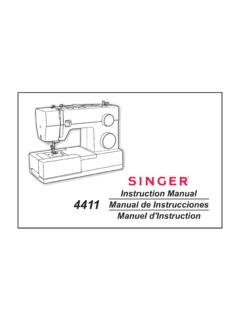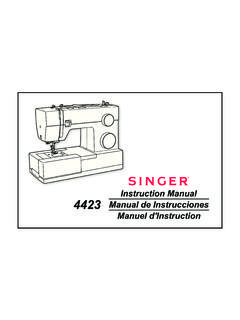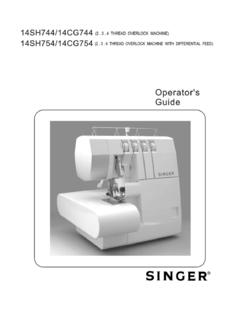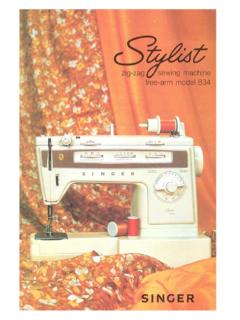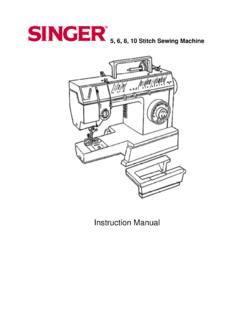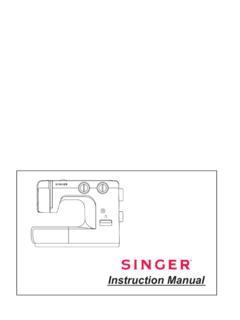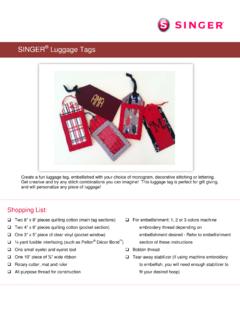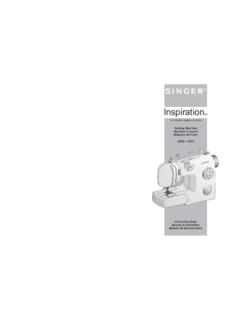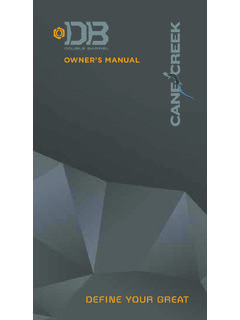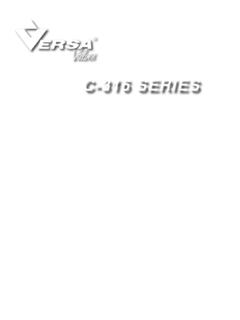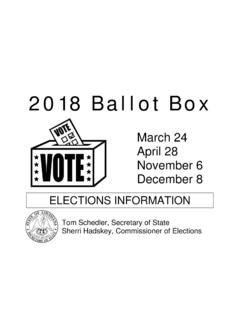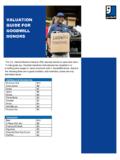Transcription of Class 99 & 99K Sewing Machines - SINGER Sewing Co.
1 Class 99 & 99 KSewing MachinesInstruction ManualTable of Contents | Next PageClass 99 & 99 KTable of ContentsInstructions forOperating the machine Electrical InformationRemove and Replace Light BulbOperate ElectricallyOperate by HandTreadle OperationProtection Against Rust DamageTo Oil the machine and StandNeedle Size ChartTo Set the NeedleUpper ThreadingTo Remove the BobbinTo Wind the BobbinTo Replace the BobbinTo Prepare for SewingTo Start SewingTo Turn a CornerBastingTo Sew Bias SeamsTo Remove the WorkTo Regulate Length of StitchTo Reverse the Direction of FeedTo Regulate Pressure on Presser FootThread TensionTo Regulate Needle Thread TensionTo Regulate Bobbin Thread TensionTo Adjust Needle & Bobbin TensionsTo Remove Bobbin CaseTo Replace Bobbin CaseTo Replace Slide Plate Sewing SuggestionsThe BeltTo Avoid Breaking NeedlesBreaking of Needle ThreadBreaking of Bobbin ThreadSkipping of StitchesMachine Working HeavilyInstructions forUsing the Attachments The Foot HemmerHemmingHemmed SeamsHemming with Lace The BinderInserting the BindingAdjustment & Operation of the BinderBinding Curved Edges The Gathering FootShirring The RufflerTo Adjust the RufflerTo Activate Parts of the RufflerGatheringForming & Attaching a Ruffle in OneOperationPleatingGroup Pleating The Seam Guide The Zipper FootPreparationInserting a Skirt ZipperSewing Corded WeltingSewing Corded Seams Fashion AidsThe ButtonholerThe Blind StitcherThe Bias GaugeThe Edge-StitcherThe QuilterThe Adjustable HemmerThe TuckerDarning or Embroidering SINGER Needles and OilPrevious Page | Next Page Class 99 & 99 KELECTRICAL INFORMATION The SINGER electric motor is located at the back of the machine , and can besupplied for operation on alternating or direct current.
2 Orders must state thecatalogue number of the motor, or the voltage, and in the case of alternatingcurrent, the number of inserting electrical plug, be sure that voltage and number of cyclesstamped on motor nameplate are within range marked on electric meter installedby electric power Connections for machine : Push three-pin safety plug into three-pinterminal block at right of machine and connect plug at other end of cord toelectric supply Controller: The speed of machine is regulated by amount of pressure onfoot or knee ! When you have finished your Sewing always disconnect theplug from the electric supply turn light "on," reach over machine arm and turn switch V, Fig. 1 to right. Toextinguish light, turn switch to 3 Table of Contents | Previous Page | Next PageClass 99 & 99 KTo Remove BulbGrasp light socket so that thumb extends over switch V. Press shade with thumbat U. to release shade from two catches, and slide it halfway out of shade holderW.
3 Press bulb into socket and at same time, turn bulb over from machine as faras it will go to unlock pin X (see Figs. 3 and 4). Withdraw the Insert New BulbPress bulb into socket and turn it over toward machine until pin X enters notch insocket (see Fig. 3). Return shade to its normal position as shown in Fig. 4 Table of Contents | Previous Page | Next PageClass 99 & 99 KIf the machine is ElectricallyOperatedRaise presser foot Q by means ofpresser bar lifter R to prevent injury tothe foot Q and feed T. Place a piece of material under presserfoot and let the foot down upon it. Turnon electric current and, if thecombination knee and foot controller isinstalled as a knee controller, pressknee lever to the right. If controller isplaced on the floor to be used as a footcontroller, press down on pedal ofcontroller. The speed of the machine iscontrolled entirely by the amount ofpresser applied to the controller. Operate machine in this way, withoutbeing threaded, until you have becomeaccustomed to guiding the material andoperating the controller.
4 Page 5 Table of Contents | Previous Page | Next PageClass 99 & 99 KIf the machine is Hand OperatedWhen the machine is uncovered, thehand attachment will be found to be outof working position as shown in Fig. 6. Pull the small spring stud 2, and turnthe handle back until leer 1, enters thesocket 3. Press back the hinged finger4, Fig. 7 between the spokes of thewheel. The machine is now ready forworking as shown in Fig. Before replacing the cover onthe machine in its case, the levershould be disengaged and the handleplaced in the position shown in Fig. 6. To Operate the Hand MachinePlace a piece of material under the presser foot Q, Fig. 5, and lower the latter bymeans of the lifter R. Now turn the handle over from you to work the machine ,without being threaded, until you are accustomed to guiding the material with theleft 6 Table of Contents | Previous Page | Next PageClass 99 & 99 KIf the machine is Treadle OperatedLoosen the hand wheel by turning motion screw L, Fig.
5 16, over toward you,place both feet upon the treadle and turn the hand wheel over toward you, at thesame time allowing the feet to move freely and lightly with the motion of thetreadle. Continue to do this until a regular and easy movement is acquired andyou are able to work the treadle so that you can re-start the machine with thewheel turning toward familiar with the working movement, tighten the hand wheel by turning thestop motions screw over from you, and place a piece of material under thepresser foot Q, Fig. 5. Lower the latter by means of the lifter and again work themachine without being threaded, until you are accustomed to guiding belt should be only just tight enough not to slip. If too loose shorten ShifterThis device simplifies throwing off andreplacing the belt. To throw off the belt,move the belt shifter to the left (see ), working the treadle at the sametime. To replace the belt, work thetreadle slowly with the hand wheelturning toward you, when a revolutionsor tow of the wheel will bring the beltback into its 7 Table of Contents | Previous Page | Next PageClass 99 & 99 KProtection Against Rust DamageLint and fluff, if not removed prior to storage will, during humid periods, absorband hold moisture, and thus accelerate rust damage to highly polished threadhandling and other exposed parts.
6 The extend of rust damage would dependupon the length of time the machine remained in idle storage where there is noventilation. Sudden drops in temperature till cause moisture to form on partswhich, if not protected by a film of oil, would rust and damage while in storage care suggests thorough brush-cleaning to remove all traces of lintand fluff, followed by swabbing of all the exposed parts in Figs. 10 and 11 with alint-free brush saturated with SINGER oil. SINGER lint-free brush may bepurchased at your local SINGER 8 Table of Contents | Previous Page | Next PageClass 99 & 99 KTo Oil the machine and StandIf the machine is used continuously, it should be oiled daily. If moderately used, anoccasional oiling is sufficient. Apply one drop of oil at teach of the places indicatedby the unlettered arrows in Figs. 9, 10 and 12 and carefully clean the machine toinsure smooth and satisfactory performance. Oil holes are provided in the machinefor bearings which cannot be directly face plate D, Fig.
7 9 by taking out screw C and loosening screw E near thetop of the place. Slip plate over screw E. Oil the points indicated in Fig 10 andthen replace face plate the slide to the left (as shown in Fig. 9) and, after removing the lint and dustwhich may have accumulated (see instructions on page 24), apply a drop of oil atthe place indicated at F, Fig. 11. The slide should then be 9 Table of Contents | Previous Page | Next PageClass 99 & 99 KTo oil the parts underneath the bed of the machine , turn the machine back on itshinges and apply oil to the oil holes and bearings indicated inFig. oil the stand, apply a drop of oil to the centers upon which the band wheel andtreadle work, and to both ends of the pitman rod connecting the treadle with theband oiling, run the machine rapidly for a few minutes so that the oil may reachthe bearings. Neglect to oil the machine will shorten its life and cause youtrouble and use SINGER oil.
8 Inferior oil clogs the bearings, prevents efficientworking, and causes rapid wear of the 10 Table of Contents | Previous Page | Next PageClass 99 & 99 KNeedles and ThreadFor perfect stitching, thread should be selected according to fabric to be stitched,and needle must be correct size for thread which must pass freely through eye ofthe 11 Table of Contents | Previous Page | Next PageClass 99 & 99 KTo Set the NeedleSelect the correct needle according to the table on page 11. Be sure that theneedle is not blunt or bent. Raise the needle bar to its highest position andloosen thumb screw H, Fig. 13 in needle clamp. Push needle with its flat sidetoward the right up into needle clamp as far as it will go, then tighten the thumbscrew H. A screwdriver slot is provided for stronger clamping of needle, requiredfor attachments driven from needle clamp 12 Table of Contents | Previous Page | Next PageClass 99 & 99 KUPPER THREADINGSee Fig.
9 14. Place spool of thread onspool pin. Raise take-up lever 5 to itshighest point. Lead thread into threadguide 1, down and from right to leftbetween tension discs 2, into the loopof the take-up spring 3, under the slackthread regulator 4 (not through theeye in the thread regulator), up andfrom right to left through hole in take-uplever 5, down through guide 6 on theface plate, down through the lower wireguide 7, from left to right through theeye of the needle about two inches of threadthrough the eye of the needle withwhich to begin to 13 Table of Contents | Previous Page | Next PageClass 99 & 99 KTo Remove the BobbinRaise needle to its highest point. Draw slide plate to the left. Press bobbinejector J, Fig. 15, to raise bobbin for easy 14 Table of Contents | Previous Page | Next PageClass 99 & 99 KTo Wind the BobbinHold the hand wheel K, Fig. 16, with left hand and with right hand loosen stopmotion screw L to disengage stitching empty bobbin on bobbin winder spindle, see Fig.
10 16. Turn bobbin until holein right side engages pin in spindle. Press bobbin winder downward until latch M,Fig. 17, engages. In this position latch will hold bobbin in spool of thread on spool pin thread through guide 2 on arm of machine . Lead thread from front to rearthrough lower notch of guide through O, Fig. 17, in left side of bobbin from inside. The end of thethread must be held by hand until it is broken off by the rotation of the 15 Table of Contents | Previous Page | Next PageClass 99 & 99 KFig. 17 shows bobbin winder in position for winding. When sufficient thread hasbeen wound the winder is automatically filled bobbin from bobbin winder spindle and re-tighten stop motionscrew L, Fig. thread does not wind evenly on bobbin, loosen screw which holds thread guide3, Fig. 16. Turn guide to left if bobbin winds high on right. Turn guide to left isbobbin winds high on left. When guide is properly centered, thread will windevenly across bobbin.

